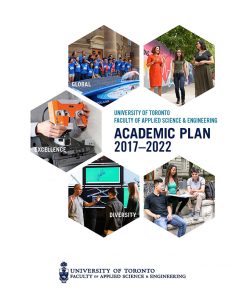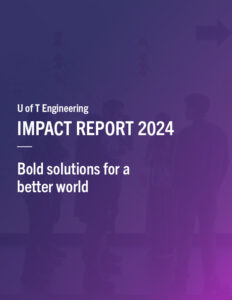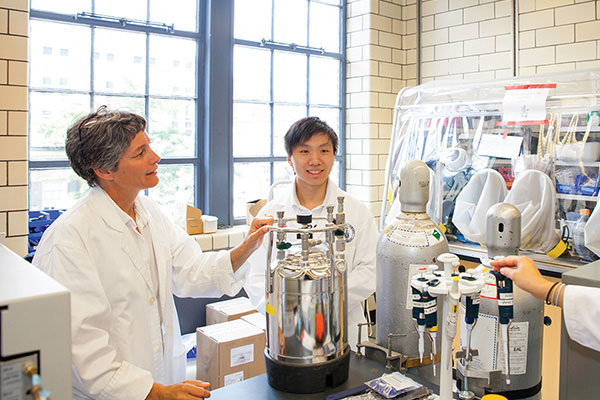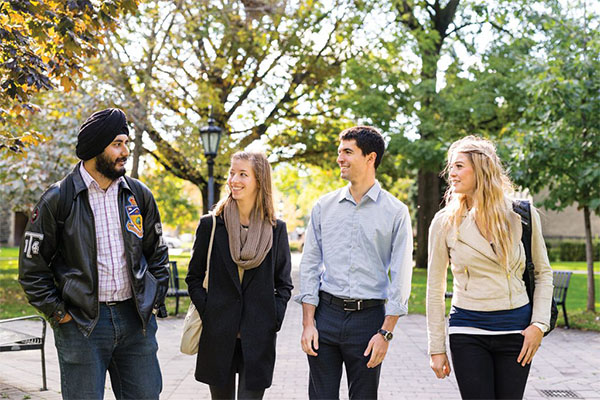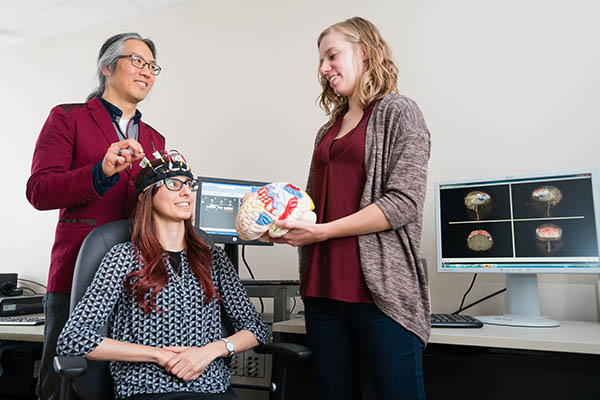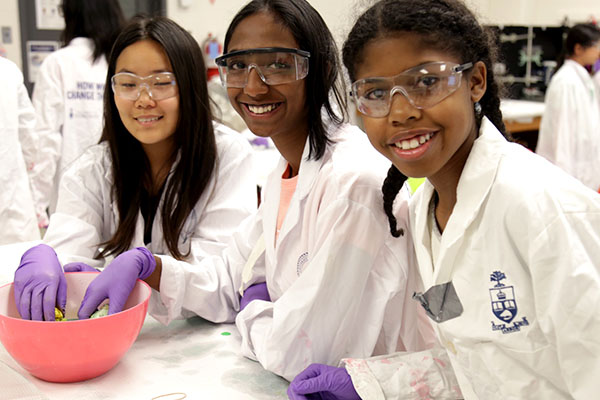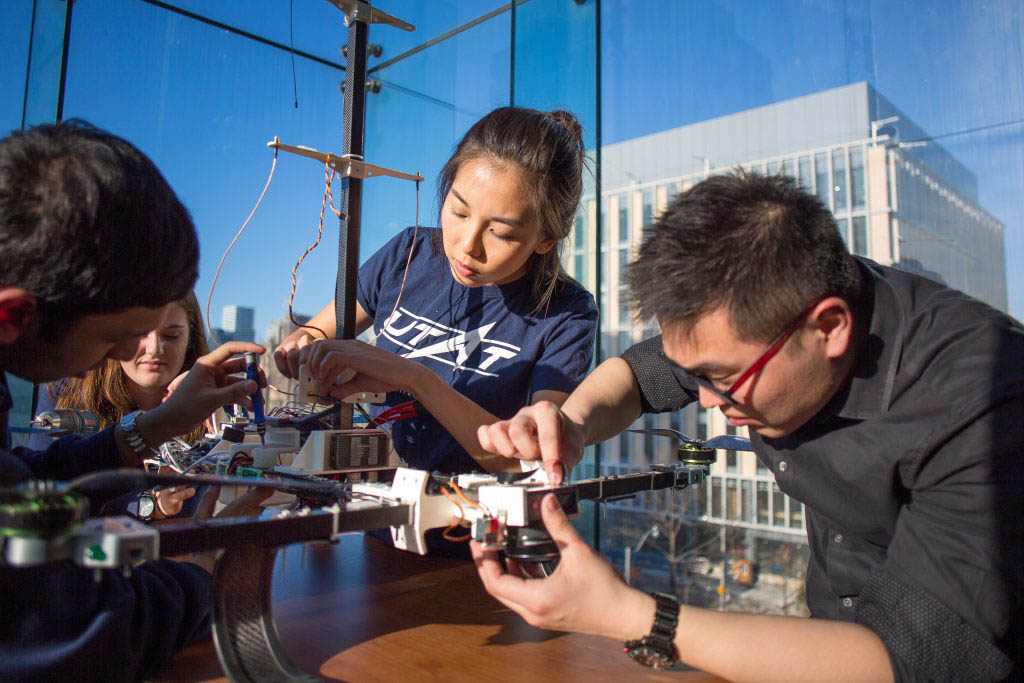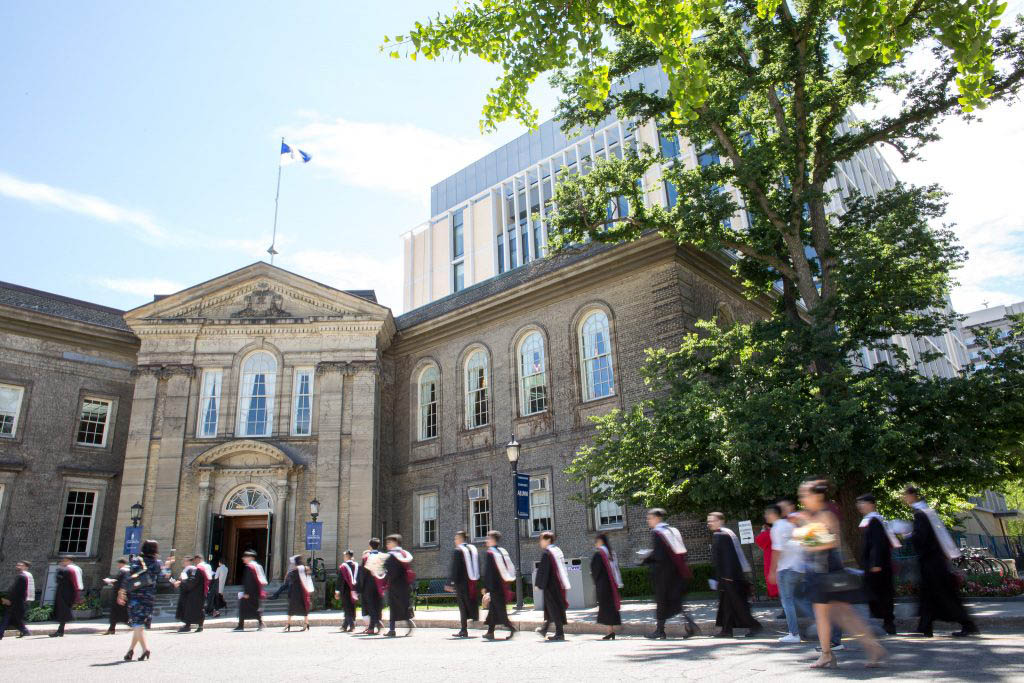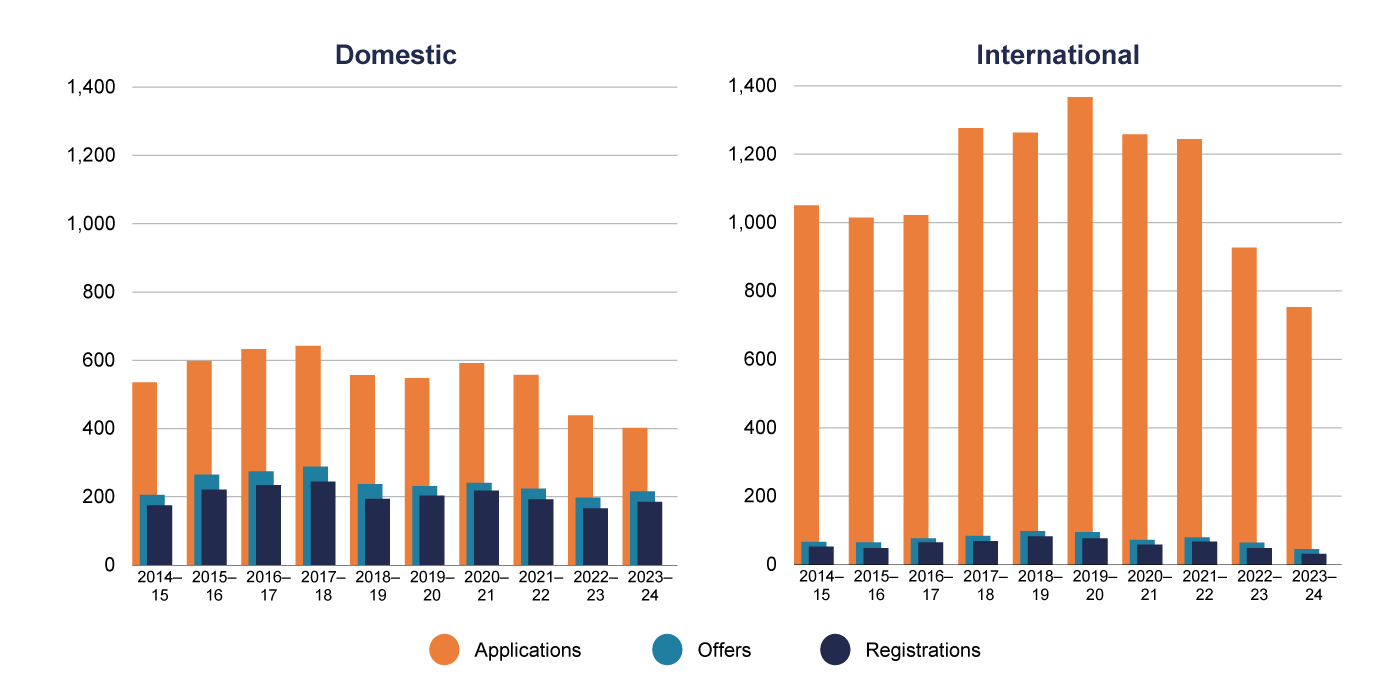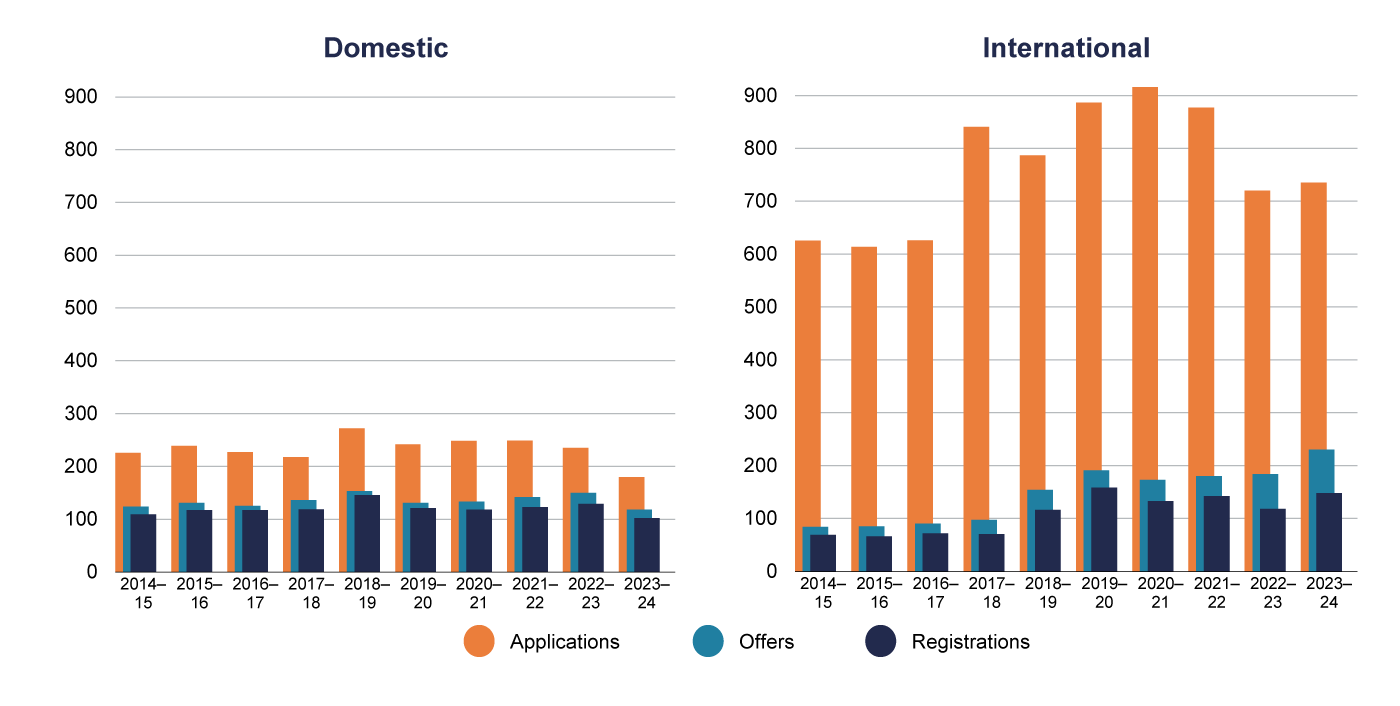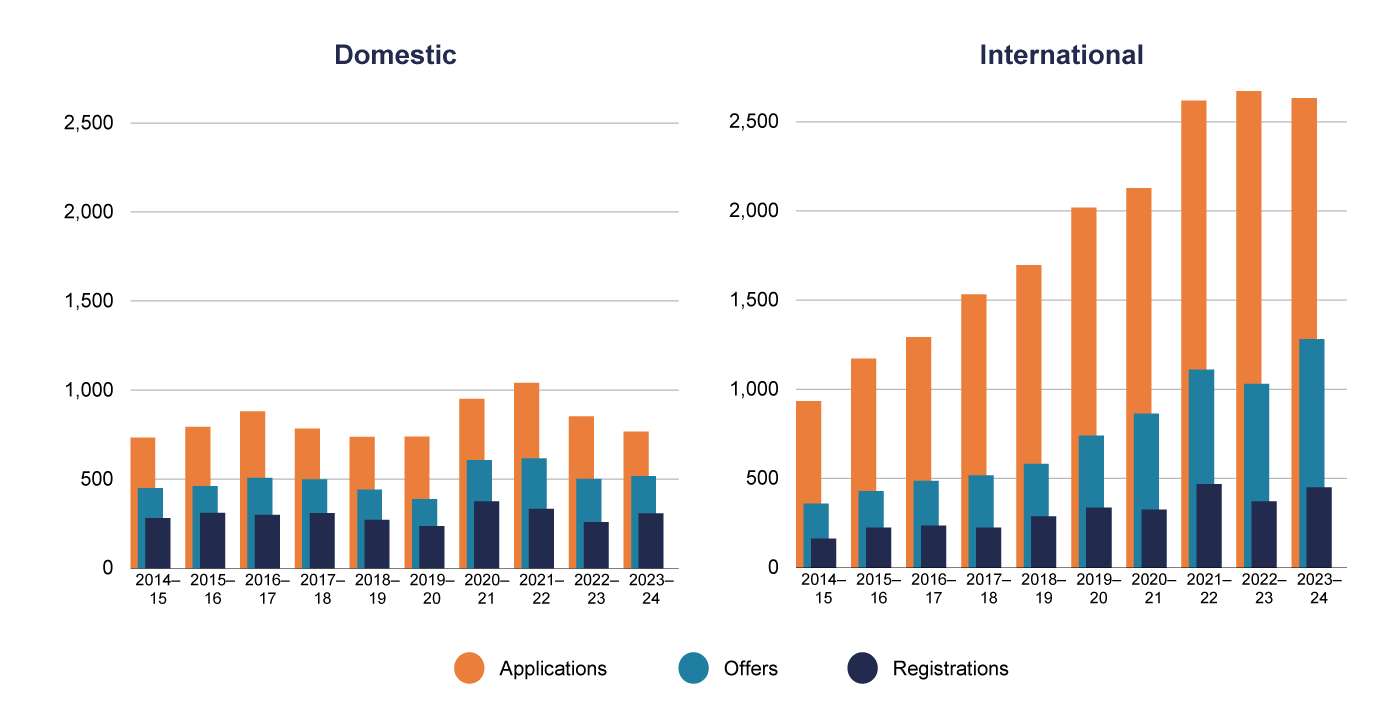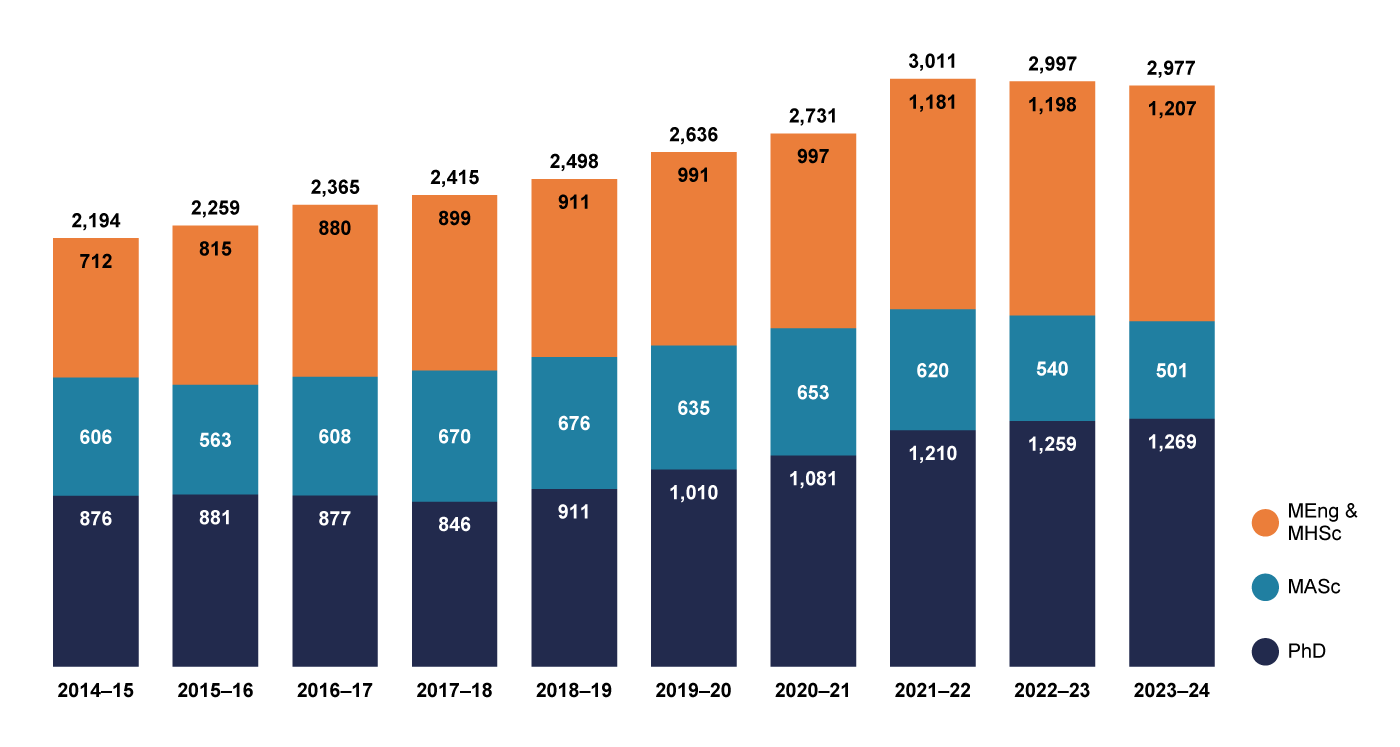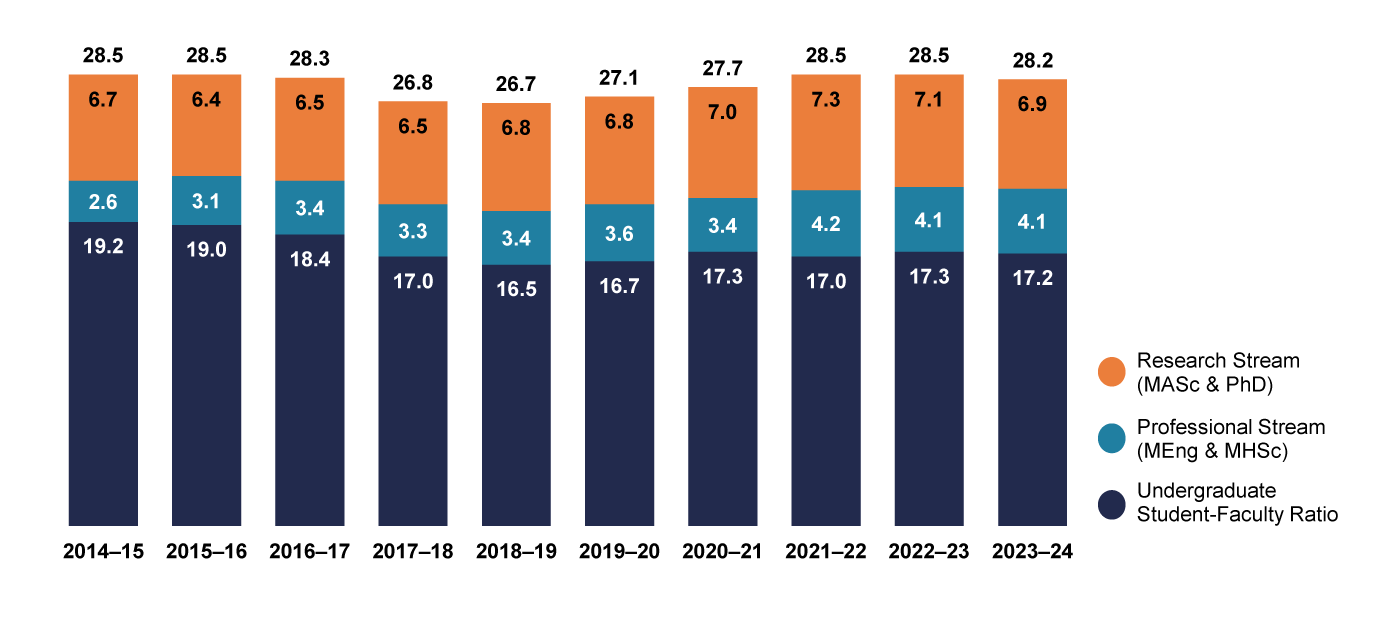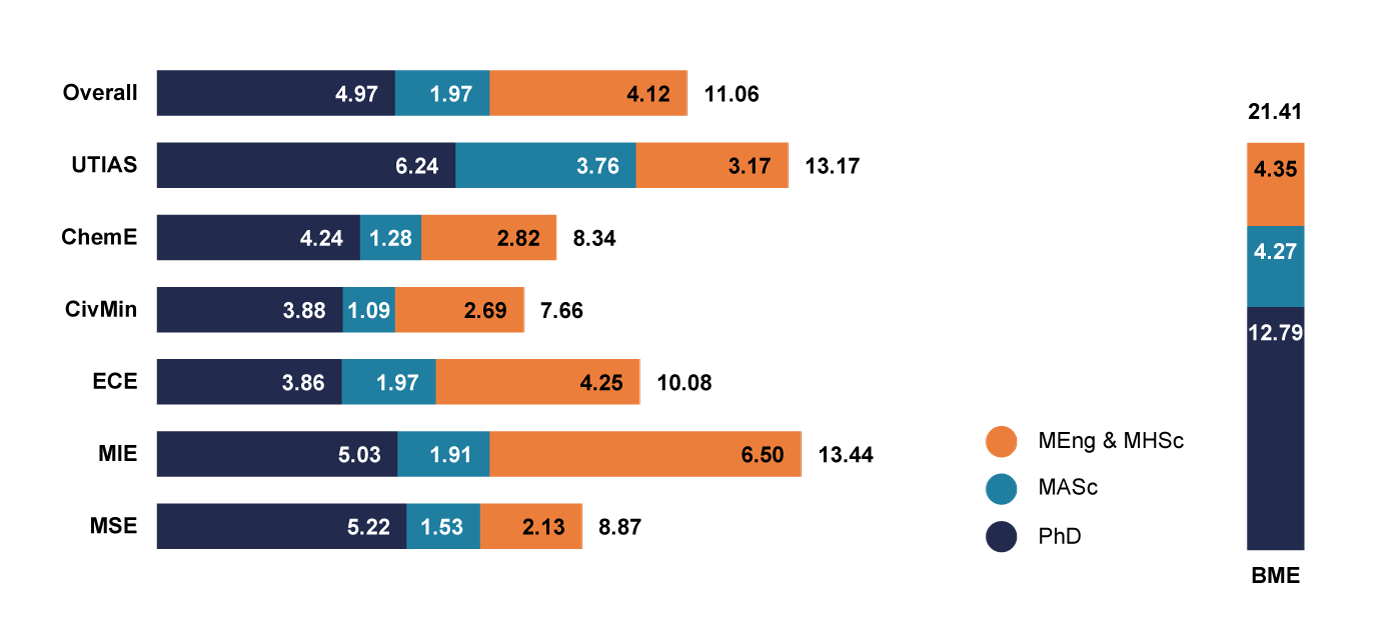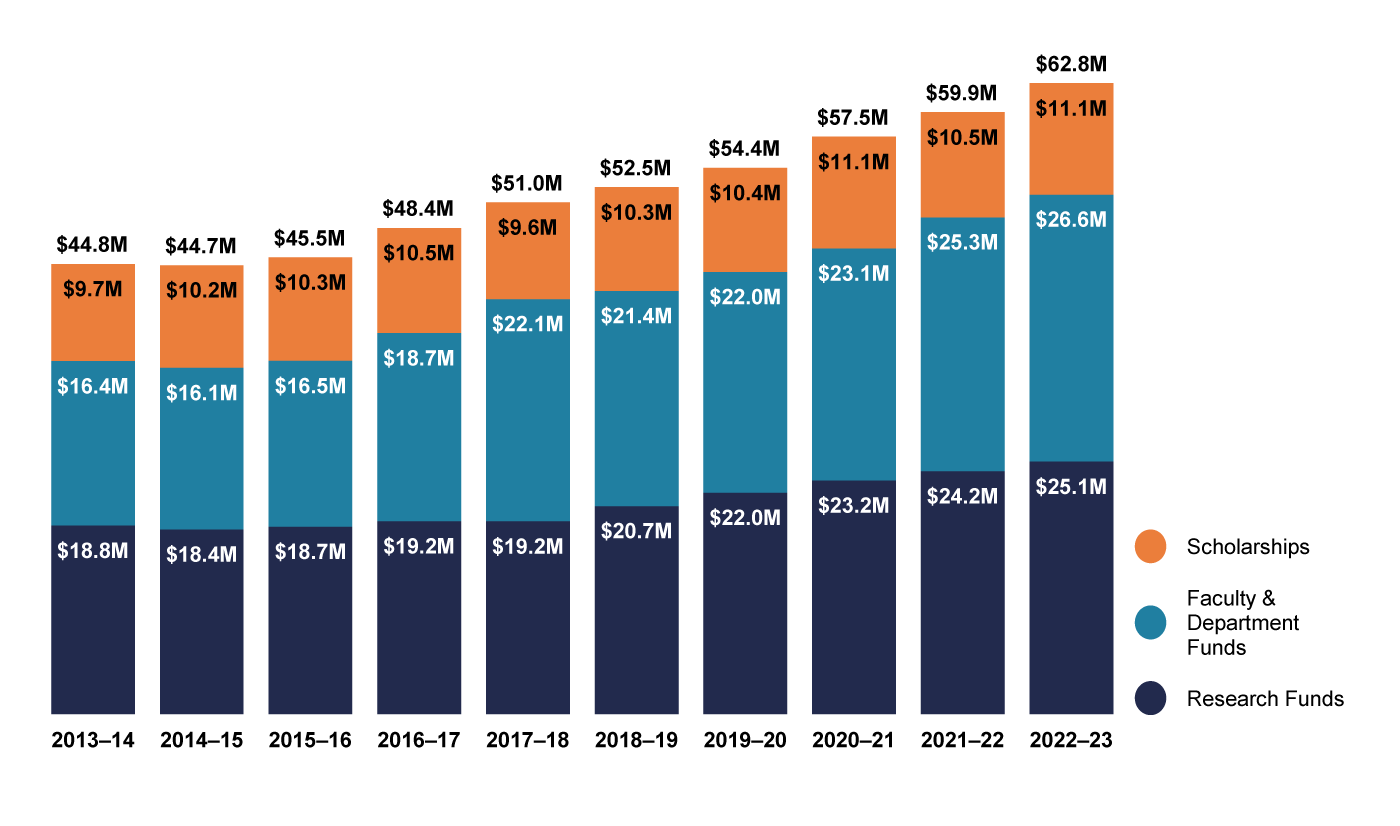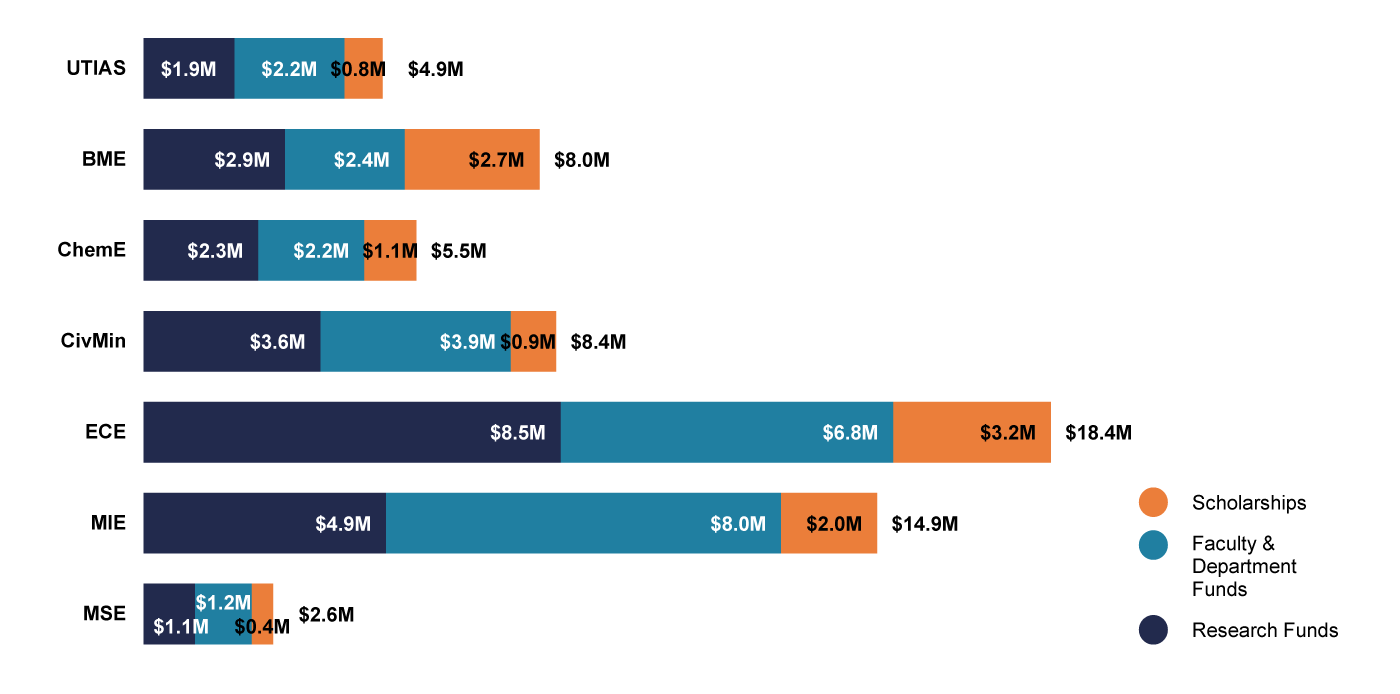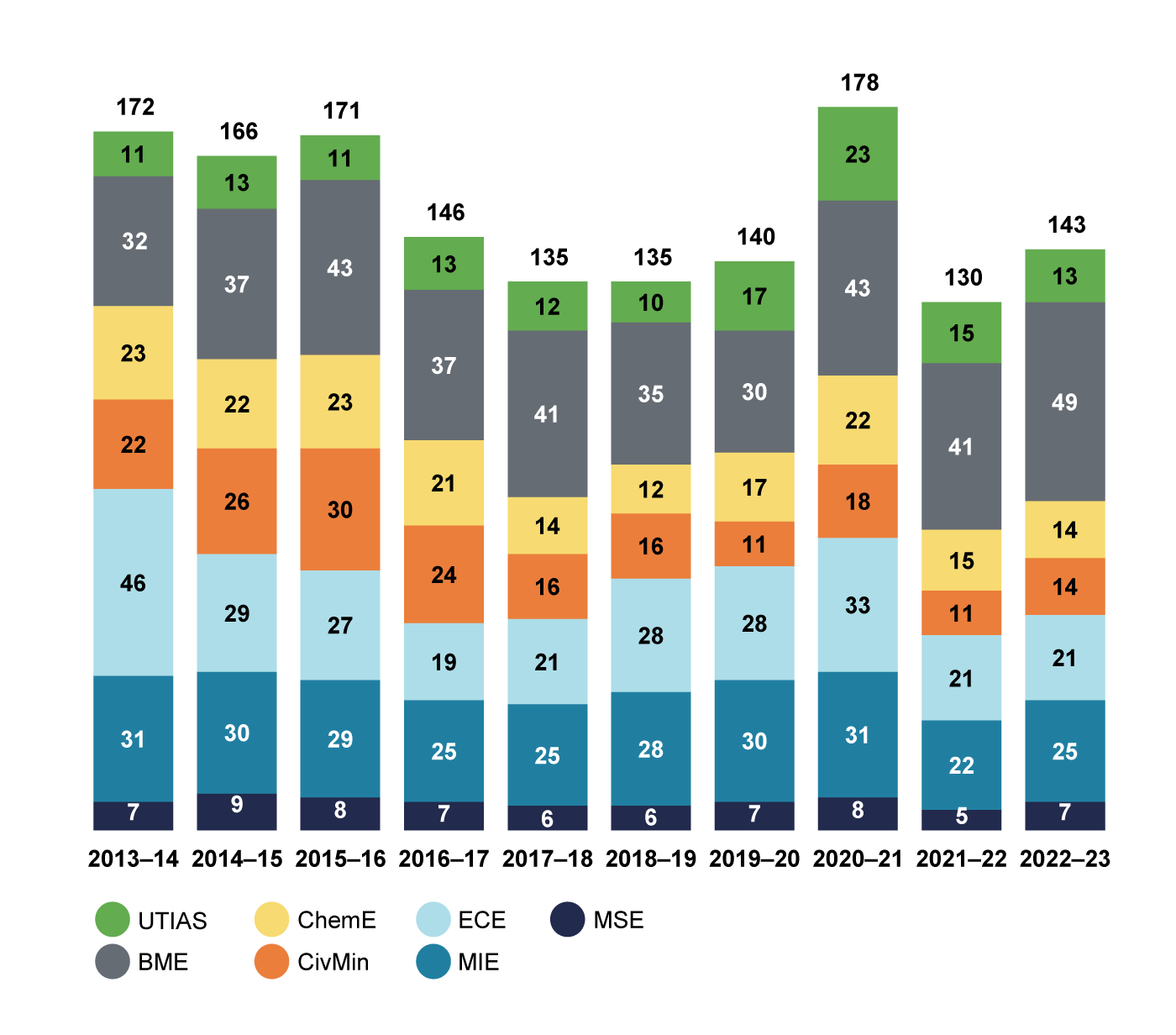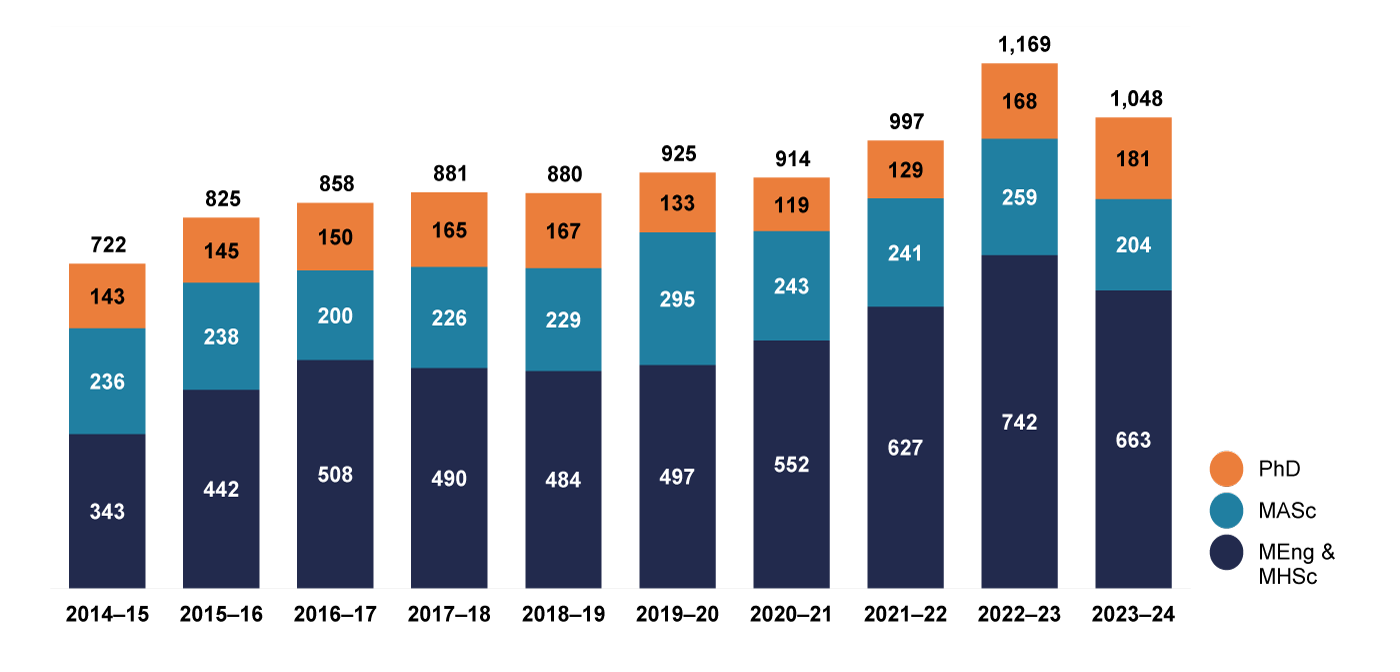By the Numbers 2024
Explore comprehensive visual data about the Faculty in this companion piece to our 2024 Impact Report
Chapter 2: Graduate Studies
Data in this chapter are presented by academic year (September to August) unless otherwise noted.
Facts & Figures
1,207
MEng students, an increase of 69.5% over the last decade
$62.8M
Total graduate student funding, an all-time high and an increase of 40.2% over the past ten years
50
Direct-entry PhD students in 2023-2024, the highest number entering via this pathway to date (Figure 2.62b)
Figure 2.1a Domestic and International MASc Students: Applications, Offers, Registrations, Selectivity and Yield, 2014–2015 to 2023–2024
Applications and offers include those received between May and April of the listed academic year. Registrations are shown as of November 1. Selectivity = offers ÷ applications and represents the proportion of applicants who were offered admission. Yield = registration ÷ offers. Domestic students are defined as citizens (living in Canada or abroad) or permanent residents of Canada.
MASc Domestic Students
| Year | Applications | Offers | Registrations | Selectivity | Yield |
|---|---|---|---|---|---|
| 2014–15 | 536 | 206 | 175 | 0.38 | 0.85 |
| 2015–16 | 598 | 265 | 221 | 0.44 | 0.83 |
| 2016–17 | 633 | 275 | 234 | 0.43 | 0.85 |
| 2017–18 | 642 | 289 | 245 | 0.45 | 0.85 |
| 2018–19 | 556 | 238 | 194 | 0.43 | 0.82 |
| 2019–20 | 548 | 232 | 204 | 0.42 | 0.88 |
| 2020–21 | 592 | 241 | 219 | 0.41 | 0.91 |
| 2021–22 | 557 | 224 | 193 | 0.4 | 0.86 |
| 2022–23 | 439 | 198 | 167 | 0.45 | 0.84 |
| 2023–24 | 402 | 216 | 186 | 0.54 | 0.86 |
MASc International Students
| Year | Applications | Offers | Registrations | Selectivity | Yield |
|---|---|---|---|---|---|
| 2014–15 | 1,050 | 66 | 52 | 0.06 | 0.79 |
| 2015–16 | 1,015 | 65 | 48 | 0.06 | 0.74 |
| 2016–17 | 1,022 | 76 | 65 | 0.07 | 0.86 |
| 2017–18 | 1,276 | 84 | 68 | 0.07 | 0.81 |
| 2018–19 | 1,263 | 98 | 82 | 0.08 | 0.84 |
| 2019–20 | 1,367 | 94 | 76 | 0.07 | 0.81 |
| 2020–21 | 1,258 | 72 | 58 | 0.06 | 0.81 |
| 2021–22 | 1,244 | 80 | 67 | 0.06 | 0.84 |
| 2022–23 | 927 | 64 | 48 | 0.07 | 0.75 |
| 2023–24 | 753 | 45 | 31 | 0.06 | 0.69 |
Figure 2.1b Domestic and International PhD Students: Applications, Offers, Registrations, Selectivity and Yield, 2014–2015 to 2023–2024
Applications and offers include those received between May and April of the listed academic year. Registrations are shown as of November 1. Selectivity = offers ÷ applications and represents the proportion of applicants who were offered admission. Yield = registration ÷ offers. Domestic students are defined as citizens (living in Canada or abroad) or permanent residents of Canada. Students who have fast-tracked from Masters programs into PhD programs are counted in this figure as applications, offers and registrations.
PhD Domestic Students
| Year | Applications | Offers | Registrations | Selectivity | Yield |
|---|---|---|---|---|---|
| 2014–15 | 226 | 124 | 109 | 0.55 | 0.88 |
| 2015–16 | 239 | 131 | 117 | 0.55 | 0.89 |
| 2016–17 | 227 | 125 | 117 | 0.55 | 0.94 |
| 2017–18 | 218 | 136 | 119 | 0.62 | 0.88 |
| 2018–19 | 272 | 153 | 146 | 0.56 | 0.95 |
| 2019–20 | 242 | 131 | 121 | 0.54 | 0.92 |
| 2020–21 | 248 | 133 | 118 | 0.54 | 0.89 |
| 2021–22 | 249 | 142 | 123 | 0.57 | 0.87 |
| 2022–23 | 235 | 150 | 129 | 0.64 | 0.86 |
| 2023–24 | 180 | 118 | 102 | 0.66 | 0.86 |
PhD International Students
| Year | Applications | Offers | Registrations | Selectivity | Yield |
|---|---|---|---|---|---|
| 2014–15 | 625 | 84 | 69 | 0.13 | 0.82 |
| 2015–16 | 614 | 85 | 66 | 0.14 | 0.78 |
| 2016–17 | 626 | 90 | 72 | 0.14 | 0.8 |
| 2017–18 | 841 | 97 | 70 | 0.12 | 0.72 |
| 2018–19 | 787 | 154 | 116 | 0.2 | 0.75 |
| 2019–20 | 887 | 191 | 158 | 0.22 | 0.83 |
| 2020–21 | 916 | 173 | 133 | 0.19 | 0.77 |
| 2021–22 | 877 | 180 | 142 | 0.21 | 0.79 |
| 2022–23 | 720 | 184 | 118 | 0.26 | 0.64 |
| 2023–24 | 735 | 230 | 148 | 0.31 | 0.64 |
Figure 2.1c Domestic and International MEng and MHSc Students: Applications, Offers, Registrations, Selectivity and Yield, 2014–2015 to 2023–2024
Applications and offers include those received between May and April of the listed academic year. Registrations are shown as of November 1. Selectivity = offers ÷ applications and represents the proportion of applicants who were offered admission. Yield = registration ÷ offers. Domestic students are defined as citizens (living in Canada or abroad) or permanent residents of Canada.
MEng and MHSc Domestic Students
| Year | Applications | Offers | Registrations | Selectivity | Yield |
|---|---|---|---|---|---|
| 2014–15 | 734 | 450 | 282 | 0.61 | 0.63 |
| 2015–16 | 794 | 461 | 311 | 0.58 | 0.67 |
| 2016–17 | 881 | 506 | 299 | 0.57 | 0.59 |
| 2017–18 | 784 | 498 | 309 | 0.64 | 0.62 |
| 2018–19 | 737 | 441 | 272 | 0.6 | 0.62 |
| 2019–20 | 739 | 388 | 236 | 0.53 | 0.61 |
| 2020–21 | 951 | 607 | 375 | 0.64 | 0.62 |
| 2021–22 | 1,041 | 617 | 333 | 0.59 | 0.54 |
| 2022–23 | 853 | 502 | 260 | 0.59 | 0.52 |
| 2023–24 | 767 | 516 | 308 | 0.67 | 0.6 |
MEng and MHSc International Students
| Year | Applications | Offers | Registrations | Selectivity | Yield |
|---|---|---|---|---|---|
| 2014–15 | 932 | 359 | 162 | 0.39 | 0.45 |
| 2015–16 | 1,171 | 429 | 223 | 0.37 | 0.52 |
| 2016–17 | 1,292 | 486 | 235 | 0.38 | 0.48 |
| 2017–18 | 1,531 | 517 | 224 | 0.34 | 0.43 |
| 2018–19 | 1,695 | 580 | 287 | 0.34 | 0.49 |
| 2019–20 | 2,019 | 739 | 335 | 0.37 | 0.45 |
| 2020–21 | 2,127 | 862 | 325 | 0.41 | 0.38 |
| 2021–22 | 2,617 | 1,109 | 468 | 0.42 | 0.42 |
| 2022–23 | 2,671 | 1,030 | 371 | 0.39 | 0.36 |
| 2023–24 | 2,633 | 1,282 | 449 | 0.49 | 0.35 |
Figure 2.2b Graduate Enrolment by Full-Time Equivalent (FTE) and Headcount (HC) by Academic Area, 2014–2015 to 2023–2024
Student counts are shown as of November 1, 2023. All graduate students affiliated with ISTEP are part of collaborative programs with degrees granted by one of the other graduate units; in the figures in this chapter, these students are counted under their home unit.
| Year | UTIAS | BME | ChemE | CivMin | ECE | MIE | MSE | Total | |
|---|---|---|---|---|---|---|---|---|---|
| 2013–14 | FTE | 182.4 | 228 | 238 | 293.1 | 531.5 | 511.2 | 80.3 | 2,064.50 |
| HC | 188 | 228 | 245 | 312 | 577 | 563 | 81 | 2,194 | |
| 2014–15 | FTE | 143.2 | 241 | 253 | 299.4 | 591.5 | 532.9 | 79 | 2,140.00 |
| HC | 146 | 241 | 260 | 326 | 637 | 570 | 79 | 2,259 | |
| 2015–16 | FTE | 178.2 | 269 | 245 | 306.3 | 577 | 580.3 | 92.3 | 2,248.10 |
| HC | 181 | 269 | 252 | 335 | 619 | 616 | 93 | 2,365 | |
| 2016–17 | FTE | 170.1 | 296 | 246.7 | 313 | 551.5 | 602.8 | 94.9 | 2,275.00 |
| HC | 175 | 303 | 253 | 348 | 597 | 642 | 97 | 2,415 | |
| 2017–18 | FTE | 191.4 | 283.3 | 219.5 | 304 | 618.8 | 658 | 94.9 | 2,369.90 |
| HC | 197 | 291 | 223 | 332 | 658 | 700 | 97 | 2,498 | |
| 2018–19 | FTE | 226.2 | 327.1 | 235 | 349.9 | 630.2 | 641.8 | 95.6 | 2,505.80 |
| HC | 236 | 332 | 242 | 380 | 668 | 681 | 97 | 2,636 | |
| 2019–20 | FTE | 258.8 | 350.9 | 229 | 371.8 | 613.8 | 657.8 | 101.9 | 2,584.00 |
| HC | 270 | 353 | 236 | 404 | 653 | 711 | 104 | 2,731 | |
| 2020–21 | FTE | 279.6 | 360.5 | 239 | 396.7 | 664 | 812.6 | 117.2 | 2,869.60 |
| HC | 288 | 364 | 246 | 424 | 706 | 863 | 120 | 3,011 | |
| 2021–22 | FTE | 234 | 349.2 | 254.3 | 338.6 | 768.3 | 770.9 | 124.9 | 2,840.20 |
| HC | 241 | 352 | 262 | 361 | 825 | 829 | 127 | 2,997 | |
| 2022–23 | FTE | 223.9 | 381.6 | 248.8 | 321.2 | 783.5 | 739.5 | 104.9 | 2,803.40 |
| HC | 233 | 383 | 260 | 345 | 850 | 799 | 107 | 2,977 |
Figure 2.3b Full-Time Equivalent Graduate Student-to-Faculty Ratios by Academic Area and Degree Type, 2023–2024
Some students in BME are supervised by faculty members from the Faculties of Medicine and Dentistry and affiliated hospitals, as well as from other departments within U of T Engineering. Because the ratio includes only faculty with a budgetary appointment in BME, comparisons with other Engineering departments are not possible. For that reason, this figure shows BME in a visually distinct way. In cases of inter-departmental supervision within the Faculty, PhD and MASc students are assigned 100% to their primary supervisor’s department.
Figure 2.4b Graduate Student Funding by Category and Academic Area, 2022–2023
For graduate student funding figures, a slip year is used to include funding received during the summer term. All graduate students affiliated with ISTEP are part of collaborative programs with degrees granted by one of the other graduate units; in the figures in this chapter, these students are counted under their home unit.
Figure 2.5a Total Graduate Student Scholarships by Source, 2013–2014 to 2022–2023
For graduate student funding figures, a slip year is used to include funding received during the summer term.
| Year | NSERC and CIHR | OGS | External - Other | Internal | Total |
|---|---|---|---|---|---|
| 2013–14 | $4,016,673 | $1,236,666 | $386,763 | $4,026,715 | $9,666,817 |
| 2014–15 | $3,975,701 | $1,336,670 | $403,762 | $4,492,771 | $10,208,904 |
| 2015–16 | $3,875,675 | $1,223,331 | $366,335 | $4,818,839 | $10,284,180 |
| 2016–17 | $3,539,878 | $1,360,004 | $333,919 | $5,237,213 | $10,471,014 |
| 2017–18 | $3,259,319 | $1,525,000 | $286,908 | $4,571,797 | $9,643,024 |
| 2018–19 | $3,390,489 | $1,443,333 | $508,399 | $4,986,623 | $10,328,844 |
| 2019–20 | $3,593,330 | $1,491,670 | $490,855 | $4,787,185 | $10,363,040 |
| 2020–21 | $3,818,085 | $1,418,336 | $543,783 | $5,342,620 | $11,122,825 |
| 2021–22 | $3,318,493 | $1,523,329 | $323,674 | $5,307,266 | $10,472,762 |
| 2022–23 | $3,295,840 | $1,570,011 | $227,967 | $5,981,726 | $11,075,544 |
Figure 2.5b Number of NSERC and CIHR Graduate Student Award Recipients by Academic Area, 2013–2014 to 2022–2023
For graduate student funding figures, a slip year is used to include funding received during the summer term. All graduate students affiliated with ISTEP are part of collaborative programs with degrees granted by one of the other graduate units; in the figures in this chapter, these students are counted under their home unit.
Figure 2.6a Number of Students Fast-Tracked from Masters to PhD by Academic Area, 2014–2015 to 2023–2024
For counting purposes, the academic year is from May to April. All graduate students affiliated with ISTEP are part of collaborative programs with degrees granted by one of the other graduate units; in the figures in this chapter, these students are counted under their home unit.
| Year | UTIAS | BME | ChemE | CivMin | ECE | MIE | MSE | Total |
|---|---|---|---|---|---|---|---|---|
| 2014–15 | 10 | 12 | 8 | 1 | 5 | 2 | 4 | 42 |
| 2015–16 | 1 | 14 | 5 | 5 | 4 | 8 | 2 | 39 |
| 2016–17 | 3 | 8 | 7 | 5 | 3 | 13 | 2 | 41 |
| 2017–18 | 10 | 11 | 5 | 7 | 6 | 6 | 45 | |
| 2018–19 | 5 | 15 | 6 | 3 | 14 | 3 | 46 | |
| 2019–20 | 6 | 4 | 6 | 2 | 11 | 3 | 2 | 34 |
| 2020–21 | 9 | 11 | 7 | 4 | 12 | 7 | 50 | |
| 2021–22 | 11 | 7 | 3 | 3 | 13 | 13 | 3 | 53 |
| 2022–23 | 8 | 15 | 5 | 8 | 5 | 12 | 2 | 55 |
| 2023–24 | 5 | 4 | 4 | 1 | 7 | 11 | 4 | 36 |
Figure 2.6b Number of Direct-Entry PhD students by Academic Area, 2014–2015 to 2023–2024
For counting purposes, the academic year is from May to April. All graduate students affiliated with ISTEP are part of collaborative programs with degrees granted by one of the other graduate units; in the figures in this chapter, these students are counted under their home unit.
| Year | UTIAS | BME | ChemE | CivMin | ECE | MIE | MSE | Total |
|---|---|---|---|---|---|---|---|---|
| 2014–15 | 3 | 2 | 5 | |||||
| 2015–16 | 5 | 5 | 2 | 12 | ||||
| 2016–17 | 7 | 1 | 1 | 2 | 4 | 15 | ||
| 2017–18 | 11 | 2 | 13 | |||||
| 2018–19 | 9 | 12 | 2 | 2 | 2 | 27 | ||
| 2019–20 | 2 | 21 | 7 | 4 | 4 | 3 | 41 | |
| 2020–21 | 1 | 23 | 6 | 2 | 3 | 2 | 5 | 42 |
| 2021–22 | 19 | 7 | 3 | 3 | 2 | 3 | 37 | |
| 2022–23 | 1 | 15 | 6 | 3 | 2 | 5 | 5 | 37 |
| 2023–24 | 1 | 20 | 7 | 4 | 6 | 9 | 3 | 50 |
Figure 2.7a Time to Completion for PhD, MASc, MEng and MHSc Students, 2014–2015 to 2023–2024
The MHSc program admitted its last students in 2019.
| Year | PhD | MASc | MEng & MHSc (FT) | MEng (ExtFT) | MEng (PT) |
|---|---|---|---|---|---|
| 2014–15 | 5.3 | 2 | 1 | 1.3 | 2 |
| 2015–16 | 5.3 | 2 | 1 | 1.7 | 2 |
| 2016–17 | 5.3 | 2 | 1 | 1.7 | 2.3 |
| 2017–18 | 5 | 2 | 1 | 1.7 | 2 |
| 2018–19 | 5.3 | 2 | 1 | 1.7 | 2 |
| 2019–20 | 5 | 2 | 1 | 1.7 | 2 |
| 2020–21 | 5.3 | 2 | 1 | 1.7 | 2 |
| 2021–22 | 5.3 | 2 | 1 | 1.7 | 2 |
| 2022–23 | 5 | 2 | 1 | 1.7 | 2 |
| 2023–24 | 5.3 | 2 | 1 | 1.7 | 2 |
Figure 2.7b Time to Completion for Graduate Students – University of Toronto Institute for Aerospace Studies, 2014–2015 to 2023–2024
| Year | PhD | MASc | MEng (FT) | MEng (Ext FT) | MEng (PT) |
|---|---|---|---|---|---|
| 2014–15 | 5.7 | 2 | 1 | 1.7 | 2 |
| 2015–16 | 6.3 | 2 | 1 | 1.7 | 2.3 |
| 2016–17 | 5.3 | 2 | 1 | 1.7 | 3 |
| 2017–18 | 5 | 2 | 1 | 1.7 | 3 |
| 2018–19 | 5.8 | 2 | 1 | 1.7 | |
| 2019–20 | 6 | 2 | 1 | 1.7 | 2.3 |
| 2020–21 | 5.7 | 2 | 1 | 1.7 | 2 |
| 2021–22 | 6 | 2 | 1 | 1.7 | 2.2 |
| 2022–23 | 5.8 | 2 | 1 | 1.7 | 2 |
| 2023–24 | 6.8 | 2 | 1 | 1.7 | 2.2 |
Figure 2.7c Time to Completion for Graduate Students – Institute of Biomedical Engineering, 2014–2015 to 2023–2024
The MHSc program admitted its last students in 2019.
| Year | PhD | MASc | MEng (FT) | MEng (Ext FT) | MEng (PT) | MHSc (FT) |
|---|---|---|---|---|---|---|
| 2014–15 | 6 | 2.3 | 2 | |||
| 2015–16 | 5.7 | 2 | 2 | |||
| 2016–17 | 5.2 | 2 | 2 | |||
| 2017–18 | 5.3 | 2.3 | 1 | 2 | ||
| 2018–19 | 5.5 | 2 | 1 | 1.3 | 2 | |
| 2019–20 | 6 | 2 | 1 | 1.7 | 2 | |
| 2020–21 | 6 | 2.3 | 1 | 1.7 | 2 | |
| 2021–22 | 5.7 | 2 | 1 | 1.3 | 2.3 | |
| 2022–23 | 6 | 2.2 | 1 | 1.7 | 1.3 | |
| 2023–24 | 6 | 2 | 1 | 1.7 | 1.7 |
Figure 2.7d Time to Completion for Graduate Students – Department of Chemical Engineering & Applied Chemistry, 2014–2015 to 2023–2024
| Year | PhD | MASc | MEng (FT) | MEng (Ext FT) | MEng (PT) |
|---|---|---|---|---|---|
| 2014–15 | 5.7 | 2 | 1 | 1.5 | 1.8 |
| 2015–16 | 5.7 | 2.3 | 1 | 1.7 | 1.5 |
| 2016–17 | 5.5 | 2 | 1 | 1.7 | 2 |
| 2017–18 | 5.8 | 2 | 1 | 1.7 | 1.7 |
| 2018–19 | 5.5 | 2 | 1 | 1.7 | 1.7 |
| 2019–20 | 6.3 | 2 | 1 | 1.8 | |
| 2020–21 | 5.3 | 2.3 | 1 | 1.7 | 2 |
| 2021–22 | 5 | 2.3 | 1 | 2 | 3 |
| 2022–23 | 5.3 | 2.3 | 1 | 1.7 | 1.8 |
| 2023–24 | 5.3 | 2 | 1 | 1.7 | 2 |
Figure 2.7e Time to Completion for Graduate Students – Department of Civil & Mineral Engineering, 2014–2015 to 2023–2024
| Year | PhD | MASc | MEng (FT) | MEng (Ext FT) | MEng (PT) | MEngCEM (FT) | MEngCEM (Ext FT) |
|---|---|---|---|---|---|---|---|
| 2014–15 | 5.3 | 2 | 1 | 1.3 | 1.7 | 1.3 | |
| 2015–16 | 5.3 | 2 | 1 | 1.7 | 2 | 1.3 | |
| 2016–17 | 5.7 | 2 | 1 | 1.3 | 2.2 | 1.3 | |
| 2017–18 | 5 | 2 | 1 | 1.3 | 2 | 1.3 | 1.3 |
| 2018–19 | 5.2 | 2 | 1 | 1.3 | 1.7 | 1.3 | 1.5 |
| 2019–20 | 4.3 | 2 | 1 | 1.3 | 2.3 | 1.3 | 1.7 |
| 2020–21 | 5.3 | 2 | 1 | 1.3 | 2.2 | 1.3 | |
| 2021–22 | 5.7 | 2 | 1 | 1.5 | 2 | 1 | 1.7 |
| 2022–23 | 5.3 | 2 | 1 | 1.3 | 2 | 1 | 1.5 |
| 2023–24 | 5.7 | 2 | 1 | 1.5 | 2.3 | 1 | 1.3 |
Figure 2.7f Time to Completion for Graduate Students – The Edward S. Rogers Sr. Department of Electrical & Computer Engineering, 2014–2015 to 2023–2024
| Year | PhD | MASc | MEng (FT) | MEng (Ext FT) | MEng (PT) | MEngDM (PT) |
|---|---|---|---|---|---|---|
| 2014–15 | 5 | 2.3 | 1 | 1.3 | 2 | 2.7 |
| 2015–16 | 5 | 2 | 1 | 1.3 | 2 | 2.3 |
| 2016–17 | 5.3 | 2 | 1 | 1.3 | 2.3 | 3.5 |
| 2017–18 | 5 | 2.3 | 1 | 1.7 | 2.7 | 2.8 |
| 2018–19 | 5.3 | 2.3 | 1 | 1.3 | 2.3 | 3 |
| 2019–20 | 5 | 2 | 1 | 1.3 | 2.3 | |
| 2020–21 | 5.5 | 2.3 | 1 | 1.7 | 2.3 | |
| 2021–22 | 5.7 | 2 | 1 | 1.3 | 2.3 | |
| 2022–23 | 5 | 2 | 1 | 1.7 | 2.3 | |
| 2023–24 | 5.3 | 2 | 1 | 1.7 | 2.3 |
Figure 2.7g Time to Completion for Graduate Students – Department of Mechanical & Industrial Engineering, 2014–2015 to 2023–2024
| Year | PhD | MASc | MEng (FT) | MEng (Ext FT) | MEng (PT) | MEngDM (PT) |
|---|---|---|---|---|---|---|
| 2014–15 | 4.8 | 2 | 1 | 1.7 | 2 | 2.3 |
| 2015–16 | 5 | 2 | 1 | 1.7 | 1.7 | 3.5 |
| 2016–17 | 4.7 | 2 | 1 | 1.7 | 2.3 | 2.8 |
| 2017–18 | 5 | 2 | 1 | 1.7 | 2 | 3 |
| 2018–19 | 4.7 | 2 | 1 | 1.7 | 1.7 | |
| 2019–20 | 4.3 | 2 | 1 | 1.7 | 1.7 | |
| 2020–21 | 5 | 2 | 1 | 1.7 | 2 | |
| 2021–22 | 4.8 | 2 | 1 | 1.7 | 2 | |
| 2022–23 | 4.7 | 2 | 1 | 1.7 | 2 | |
| 2023–24 | 5 | 2 | 1 | 1.7 | 2 |
Figure 2.7h Time to Completion for Graduate Students – Department of Materials Science & Engineering, 2014–2015 to 2023–2024
| Year | PhD | MASc | MEng (FT) | MEng (Ext FT) | MEng (PT) |
|---|---|---|---|---|---|
| 2014–15 | 5.3 | 2 | 1 | 1.3 | 2.8 |
| 2015–16 | 5.5 | 2 | 1 | 1.7 | |
| 2016–17 | 5.8 | 2 | 1 | 1.7 | |
| 2017–18 | 5.3 | 2 | 1 | 1.7 | |
| 2018–19 | 5.3 | 2 | 1 | 1.7 | 2 |
| 2019–20 | 7 | 2.3 | 1 | 1.7 | |
| 2020–21 | 4.7 | 2.5 | 1 | 1.8 | |
| 2021–22 | 5.3 | 2.5 | 1 | 2 | |
| 2022–23 | 4.3 | 2.8 | 1 | 1.7 | 2 |
| 2023–24 | 5 | 2 | 1 | 1.3 | 3.5 |
Figure 2.9 New Graduate Courses Approved, 2023–2024
| Course Code | Course Title |
|---|---|
| AER 1404 | Aerospace Materials |
| BME 1088 | Concepts in Immunoengineering |
| BME 1452 | Polymers for Biomedical Engineering |
| CHE 2010 | PhD Research |
| CHE 3012 | MASc Research |
| CIV 1231 | Indoor Air Quality – Moisture, Microbes and Materials: |
| CIV 1323 | Pathways to Net-Zero Greenhouse Gas Emissions |
| CIV 1520 | Travel Survey Methods |
| MIE 1135 | Thermal Phenomena, Performance and Management of Electric Vehicles: |
| MIE 1520 | Learning with Graphs and Sequences |

